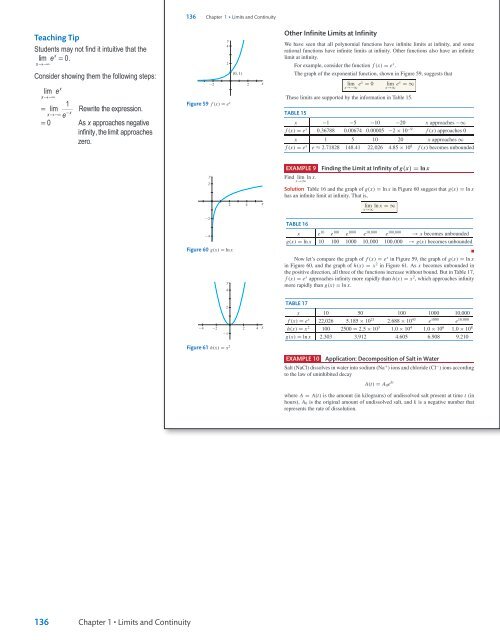Sullivan Microsite DigiSample
You also want an ePaper? Increase the reach of your titles
YUMPU automatically turns print PDFs into web optimized ePapers that Google loves.
<strong>Sullivan</strong> AP˙<strong>Sullivan</strong>˙Chapter01 October 8, 2016 17:4<br />
<strong>Sullivan</strong><br />
136 Chapter 1 • Limits and Continuity<br />
Teaching Tip<br />
Students may not find it intuitive that the<br />
x<br />
lim e = 0.<br />
x→−∞<br />
Consider showing them the following steps:<br />
lim e<br />
x<br />
x→−∞<br />
= lim 1 Rewritethe expression.<br />
x→−∞<br />
e<br />
− x<br />
= 0 As x approaches negative<br />
infinity,the limit approaches<br />
zero.<br />
y<br />
4<br />
2<br />
(0, 1)<br />
2<br />
Figure 59 f (x) = e x<br />
2<br />
x<br />
Other Infinite Limits at Infinity<br />
We have seen that all polynomial functions have infinite limits at infinity, and some<br />
rational functions have infinite limits at infinity. Other functions also have an infinite<br />
limit at infinity.<br />
For example, consider the function f (x) = e x .<br />
The graph of the exponential function, shown in Figure 59, suggests that<br />
lim<br />
x→−∞ ex = 0<br />
lim<br />
x→∞ ex =∞<br />
These limits are supported by the information in Table 15.<br />
TABLE 15<br />
x −1 −5 −10 −20 x approaches −∞<br />
f (x) = e x 0.36788 0.00674 0.00005 −2 × 10 −9 f (x) approaches 0<br />
x 1 5 10 20 x approaches ∞<br />
f (x) = e x e ≈ 2.71828 148.41 22,026 4.85 × 10 8 f (x) becomes unbounded<br />
y<br />
2<br />
EXAMPLE 9<br />
Find lim ln x.<br />
x→∞<br />
Finding the Limit at Infinity of g(x) =ln x<br />
Solution Table 16 and the graph of g(x) = ln x in Figure 60 suggest that g(x) = ln x<br />
has an infinite limit at infinity. That is,<br />
2 4<br />
x<br />
lim ln x =∞<br />
x→∞<br />
2<br />
4<br />
Figure 60 g(x) = ln x<br />
y<br />
4<br />
TABLE 16<br />
x e 10 e 100 e 1000 e 10,000 e 100,000 → x becomes unbounded<br />
g(x) = ln x 10 100 1000 10,000 100,000 → g(x) becomes unbounded<br />
Now let’s compare the graph of f (x) = e x in Figure 59, the graph of g(x) = ln x<br />
in Figure 60, and the graph of h(x) = x 2 in Figure 61. As x becomes unbounded in<br />
the positive direction, all three of the functions increase without bound. But in Table 17,<br />
f (x) = e x approaches infinity more rapidly than h(x) = x 2 , which approaches infinity<br />
more rapidly than g(x) = ln x.<br />
■<br />
24<br />
22<br />
2<br />
21<br />
2<br />
4<br />
x<br />
TABLE 17<br />
x 10 50 100 1000 10,000<br />
f (x) = e x 22,026 5.185 × 10 21 2.688 × 10 43 e 1000 e 10,000<br />
h(x) = x 2 100 2500 = 2.5 × 10 3 1.0 × 10 4 1.0 × 10 6 1.0 × 10 8<br />
g(x) = ln x 2.303 3.912 4.605 6.908 9.210<br />
Figure 61 h(x) = x 2<br />
EXAMPLE 10<br />
Application: Decomposition of Salt in Water<br />
Salt (NaCl) dissolves in water into sodium (Na + ) ions and chloride (Cl − ) ions according<br />
to the law of uninhibited decay<br />
A(t) = A 0 e kt<br />
where A = A(t) is the amount (in kilograms) of undissolved salt present at time t (in<br />
hours), A 0 is the original amount of undissolved salt, and k is a negative number that<br />
represents the rate of dissolution.<br />
136<br />
Chapter 1 • Limits and Continuity<br />
TE_<strong>Sullivan</strong>_Chapter01_PART II.indd 19<br />
11/01/17 9:56 am




